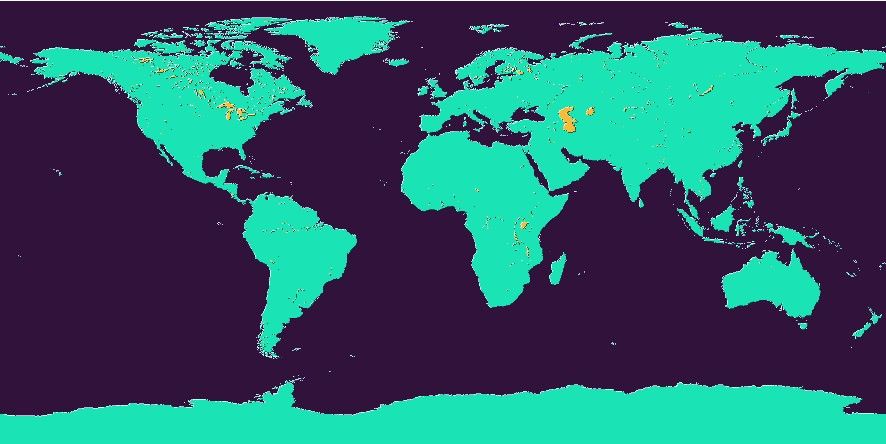pygmt.datasets.load_earth_mask
- pygmt.datasets.load_earth_mask(resolution='01d', region=None, registration='gridline')[source]
Load the GSHHG Earth mask dataset in various resolutions.

GSHHG Earth mask dataset.
This function downloads the dataset from the GMT data server, caches it in a user data directory (usually
~/.gmt/server/earth/earth_mask/), and load the dataset as anxarray.DataArray. An internet connection is required the first time around, but subsequent calls will load the dataset from the local data directory.The dataset can also be accessed by specifying a file name in any grid processing function or plotting method, using the following file name format: @earth_mask_res_reg. res is the grid resolution; reg is the grid registration type (p for pixel registration, g for gridline registration). If reg is omitted (e.g.,
@earth_mask_01d), the gridline-registered grid will be loaded for grid processing functions and the pixel-registered grid will be loaded for plotting functions. If res is also omitted (i.e.,@earth_mask), GMT automatically selects a suitable resolution based on the current region and projection settings.Refer to https://www.generic-mapping-tools.org/remote-datasets/earth-mask.html for more details about available datasets, including version information and references.
- Parameters:
resolution (
Literal['01d','30m','20m','15m','10m','06m','05m','04m','03m','02m','01m','30s','15s'], default:'01d') – The grid resolution. The suffixd,m, andsstand for arc-degrees, arc-minutes, and arc-seconds.region (
Sequence[float] |str|None, default:None) – The subregion of the grid to load, in the form of a sequence [xmin, xmax, ymin, ymax] or an ISO country code.registration (
Literal['gridline','pixel'], default:'gridline') – Grid registration type. Either"pixel"for pixel registration or"gridline"for gridline registration.
- Return type:
- Returns:
grid – The Earth mask grid. Coordinates are latitude and longitude in degrees. The node values in the mask grids are all in the 0-4 range and reflect different surface types:
0: Oceanic areas beyond the shoreline
1: Land areas inside the shoreline
2: Lakes inside the land areas
3: Islands in lakes in the land areas
4: Smaller lakes in islands that are found within lakes inside the land area
Note
The registration and coordinate system type of the returned
xarray.DataArraygrid can be accessed via the gmt accessor. Refer topygmt.GMTDataArrayAccessorfor detailed explanations and limitations.Examples
>>> from pygmt.datasets import load_earth_mask >>> # Load the default grid (gridline-registered 1 arc-degree grid) >>> grid = load_earth_mask() >>> # location (120°E, 50°N) is in land area (1) >>> grid.sel(lon=120, lat=50).values array(1, dtype=int8) >>> # location (170°E, 50°N) is in oceanic area (0) >>> grid.sel(lon=170, lat=50).values array(0, dtype=int8)